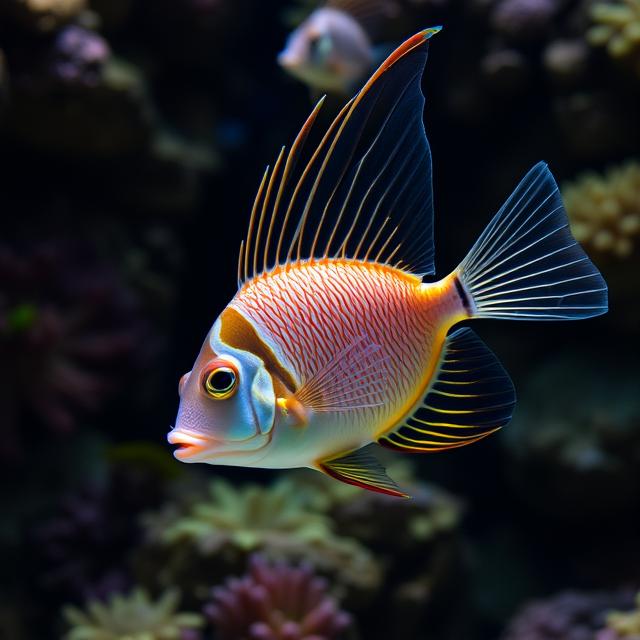
Table of Contents
As we explore the world of aquatic creatures in 2025, the angel fish shines brightly. Their majestic fins and vibrant colors make them a hit among aquarium fans and marine life enthusiasts.

In this article, we’ll dive into the world of angel fish. We’ll talk about their habitat, traits, and their role in the ocean. We’ll also share the latest trends and tips on caring for these amazing creatures.
Key Takeaways
- Discover the unique characteristics of angel fish that make them a popular choice for aquariums.
- Learn about the importance of proper care and maintenance for these aquatic creatures.
- Explore the latest trends in angel fish keeping and how they are being cared for in 2025.
- Understand the role of angel fish in the aquatic ecosystem and their impact on the environment.
- Get insights into the most common challenges faced by angel fish keepers and how to overcome them.
The Fascinating World of Angel Fish
Diving into the world of this fish reveals a fascinating array of creatures. They captivate aquarium enthusiasts worldwide. These fish are not only prized for their beauty but also for their intriguing behaviors and rich history.
Origin and Natural Habitat
This fish are native to the freshwater environments of South America. They thrive in the Amazon and Orinoco river basins. They live in slow-moving waters with dense vegetation, which provides them with shelter and abundant food sources.
Their natural habitat is characterized by soft, slightly acidic water. This is often replicated in home aquariums to ensure their health and well-being.
Key characteristics of their natural habitat include:
- Slow water flow
- Dense aquatic vegetation
- Soft, slightly acidic water
Evolutionary History and Significance
Angel fish have a long evolutionary history. Fossil records show they have remained relatively unchanged for millions of years. Their enduring presence is a testament to their adaptability and resilience.
Their significance extends beyond their beauty. They play a crucial role in their ecosystems, contributing to the balance of their natural habitats.
As aquarium enthusiasts continue to be drawn to these captivating creatures, understanding their origins and evolutionary history is key. By replicating their natural habitats and respecting their evolutionary adaptations, hobbyists can ensure that this fish continue to thrive in captivity.
Popular Angel Fish Species and Varieties in2025
In 2025, this fish are still a big hit with their many species and varieties. They are loved by many for their beauty and variety. Aquarium fans have a wide range of types to choose from.
Freshwater Angel Fish Types
Freshwater angel fish are favorites in many community tanks. The most well-known types are:
- Silver Angelfish: These fish are loved for their shiny scales.
- Zebra Angelfish: They stand out with their striped look, adding excitement to any tank.
- Veil Angelfish: Their long fins make them a hit among fish lovers.
These fish are not just pretty but also easy to care for. They are perfect for both new and seasoned fish keepers.
Saltwater Angel Fish Varieties
Saltwater this fish are less common but offer a special challenge and reward. Some notable species include:
- Queen Angelfish: Their bright colors and patterns make them a sought-after choice for big saltwater tanks.
- Rock Beauty Angelfish: Their striking looks make them a favorite for those with the right setup.
These fish need special care and tank conditions. They are best for experienced aquarists.
Newly Discovered Species
Recently, new this fish species have been found, adding to the variety for hobbyists. For example, a new species in the Amazon basin is getting a lot of attention. It has unique colors and patterns.
The discovery of new this fish species is exciting for the aquarium community. It also shows how important it is to protect these and other aquatic species.
Distinctive Physical Characteristics of Angel Fish
Angel fish have a unique body shape that helps them live in different water environments. This special body is why they are so loved by people who keep fish tanks.
Unique Body Structure and Fins
Angel fish have bodies that are flat and long fins. These fins are not just pretty; they help the fish move and stay steady in the water. Their dorsal and anal fins are especially long and flowy.
Coloration and Patterns
Angel fish come in many colors and patterns. Some have vibrant colors like silver, gold, and black. Others have softer colors. Their patterns can be simple or very detailed, making them look even more beautiful.
Size Variations Across Species
Angel fish come in different sizes, depending on the type. Some are small, while others can get quite big. For example, some freshwater this fish can grow up to 6 inches long. Saltwater species can even get bigger. Knowing the size of your fish is important to make sure they have enough room.
Setting Up the Ideal Angel Fish Aquarium
Creating an ideal this fish aquarium is more than picking a tank. It’s about making a balanced home for these beautiful fish.
Tank Size and Requirements
Choosing the right tank size is key. This fish grow big and swim a lot. They need lots of room to move. A 20-gallon tank is a good start for one fish, adding 10 gallons for each more.
The tank must have a secure lid. This fish can jump out.
Water Parameters and Conditions
Keeping the water right is vital for angel fish health. They like slightly acidic to neutral water with a pH of 6.5-7.5. The water should be between 78°F to 82°F (25°C to 28°C).
Decorations and Plant Selection
Decorations and plants make the aquarium look great. They also give this fish places to hide and claim as their own. Use live plants like Amazon swords and Java ferns, and decorations like driftwood and rocks. Stay away from sharp decorations that could hurt the fish.
Modern Filtration and Lighting Systems
A good filter is essential for clean water. Think about a canister filter or a top-notch hang-on-back filter. For lighting, LED aquarium lights are a smart choice. They save energy and help mimic day and night, keeping the fish happy.
By thinking about these things, you can make a great home for your this fish. They’ll be happy and fun to watch.
Nutrition and Feeding Guidelines for Angel Fish
Knowing what this fish need to eat is key to their health. A good diet makes their colors bright and keeps them well.
Recommended Diet Components
Angel fish eat both protein and veggies. They need high-quality flakes or pellets and live foods like brine shrimp and bloodworms. They also like lettuce and spinach.
Feeding Schedule and Techniques
Feed this fish 2-3 times a day, but just a little. This stops them from getting too full. Use a feeding ring to keep food in one spot, making it easier for them to eat.
Advanced Nutrition Developments for 2025
New feeds are coming out that are made just for this fish. These feeds help their colors, growth, and health. Adding these to their diet can really help them stay healthy and strong.
Angel Fish Behavior and Social Dynamics
Angel fish show interesting social behaviors that can be both captivating and tricky to manage. Their actions are influenced by their natural home and evolution. This makes them a fascinating topic for those who love aquariums.
Natural Behaviors to Expect
In the wild, this fish have complex behaviors like defending their territory and schooling. They also form long-term monogamous pairs when they breed. Watching these behaviors can help us understand their social structure.
- Territorial defense against other angel fish
- Pair bonding during breeding seasons
- Foraging behaviors in their natural habitat
Compatibility with Other Fish Species
When adding this fish to a community tank, it’s important to think about their compatibility with other fish. Some fish might be too aggressive or fin-nippy, stressing out the this fish.
- Avoid fin-nipping species like tiger barbs
- Choose peaceful community fish like tetras or corydoras
- Monitor the aquarium for signs of aggression
Behavioral Changes in Captivity
Angel fish may change their behavior in captivity, like eating differently or becoming more aggressive. Knowing these changes is crucial for their care.

By understanding and dealing with these changes, aquarium owners can make a better home for their angel fish.
Breeding Angel Fish Successfully
Creating the right environment is key for breeding this fish. You need to set up an aquarium that looks like their natural home. This helps them want to breed.
Optimal Breeding Conditions
To breed this fish well, you must copy their natural setting. Keep the water temperature between 78°F to 82°F and the pH between 6.5 to 7.5. Your aquarium should be big, at least 20 gallons for two fish.
- Use plants and decorations to give them places to hide.
- Make sure the water moves gently, like a river.
- Light the tank well, but not too bright.
The Breeding Process
Start by picking healthy, grown-up this fish. Put the male and female together in the tank to avoid fights. After they spawn, keep the eggs safe from the parents.
“Successful breeding of this fish requires patience and a thorough understanding of their behavior.”
Expert Aquarist
Caring for Angel Fish Fry
When the eggs hatch, the fry need careful care. Feed them infusoria or commercial fry food first, then bigger foods as they grow.
Genetic Advancements in Breeding
New genetic research has brought new chances for breeding this fish. You can now breed them for better colors or health.
Common Health Issues and Treatment for Angel Fish
To keep angel fish healthy, it’s key to know about common health problems and how to fix them. Angel fish are usually tough, but they can still get sick.
Disease Prevention Strategies
Keeping this fish healthy starts with preventing disease. The best way to do this is by keeping the water clean. Change the water often, use good filters, and check the water’s health.
- Regularly test water for ammonia, nitrite, and nitrate levels.
- Maintain a stable water temperature between 78°F to 82°F.
- Avoid overfeeding, as this can lead to water quality issues.
Recognizing Symptoms of Illness
Spotting illness early is very important. Look for signs like being very tired, not wanting to eat, breathing hard, and visible infections or parasites.
Key symptoms to monitor:
- Discoloration or unusual growths on the body.
- Fins clamped or torn.
- Rapid or labored breathing.
Treatment Options and Medications
When you see signs of illness, act fast. The treatment depends on the disease. It might include medicines for parasites, antibiotics, or making the water better.
It’s important to know what disease your fish has to pick the right treatment. If you’re not sure, ask a vet or someone who knows a lot about fish.
Emerging Veterinary Care for Aquarium Fish
The care for aquarium fish is getting better, with new treatments and tools. Keeping up with the latest can help your this fish live longer and healthier.
“Advances in veterinary care for aquarium fish have significantly improved our ability to diagnose and treat diseases in these delicate creatures.” – Aquarium Expert
2025’s Revolutionary Angel Fish Keeping Technologies
As we look ahead to 2025, the world of angel fish keeping is changing fast. New technologies are coming that will make these beautiful creatures healthier, happier, and more sustainable.
Smart Aquarium Systems
Smart aquarium systems are a big leap forward in angel fish keeping. They use advanced sensors and AI to watch over water quality, temperature, and more. This ensures the best environment for our this fish.
Key Features:
- Automated water quality monitoring
- Personalized care recommendations
- Remote access and control via mobile apps
Sustainable and Eco-Friendly Practices
Sustainability is key in modern this fish keeping. Eco-friendly practices like energy-saving filters and green aquarium materials are becoming more popular. They help reduce our impact on the environment.
| Eco-Friendly Practice | Benefit |
|---|---|
| Energy-efficient filtration | Reduced energy consumption |
| Sustainable materials | Less environmental impact |
Virtual and Augmented Reality in Fish Keeping
Virtual and augmented reality are changing how we care for our this fish. These technologies let us dive into our aquariums in new ways. They make our hobby more immersive and exciting.
Conclusion: The Enduring Appeal of Angel Fish
Angel fish have always fascinated aquarium lovers. They add elegance and peace to any water setting.
We’ve seen how amazing angel fish are. From their origins to their care, they are truly special. Their beauty and calm nature make them a favorite in aquariums.
Looking ahead, new tech and knowledge will make caring for angel fish even better. Whether you’re new or experienced, diving into the world of angel fish is exciting. It invites you to discover and enjoy their beauty.
FAQ
What are the ideal water parameters for keeping angel fish?
Angel fish do best in water that’s well-oxygenated. The pH should be between 6.8 and 7.8. The temperature should be between 78°F and 82°F (25°C to 28°C).
How often should I feed my angel fish?
Feed your angel fish 2-3 times a day. Give them a mix of high-quality flakes or pellets and live or frozen foods like brine shrimp or bloodworms.
Can angel fish be kept with other fish species?
Yes, angel fish can live with other peaceful fish. But, make sure to check if the other fish won’t bother them too much.
What are the most common health issues affecting angel fish?
Angel fish often get bacterial infections, parasitic infestations, and fungal diseases. Keeping the tank clean, quarantining new fish, and getting vet care can help prevent and treat these issues.
How can I create a natural environment for my angel fish?
Use plants like Amazon Swords or Java Moss to make the tank feel more natural. Add decorations like driftwood or rock caves for hiding spots and to make the tank look interesting.
What are the benefits of using smart aquarium systems for angel fish keeping?
Smart aquarium systems can watch the water, feed your fish automatically, and alert you to any problems. This makes it easier to keep your angel fish happy and healthy.
Can I breed angel fish in a community aquarium?
Breeding angel fish in a community tank can be hard. Other fish might eat the eggs or fry. It’s usually better to have a separate breeding tank.
How can I identify the sex of my angel fish?
Males have a more pointed anal fin and longer dorsal fin than females. But, it’s hard to tell just by looking. It’s easier to figure out when they’re showing breeding behavior.
Also Read:
Alps Tucker Carlson: Exploring the Iconic Mountain Range



